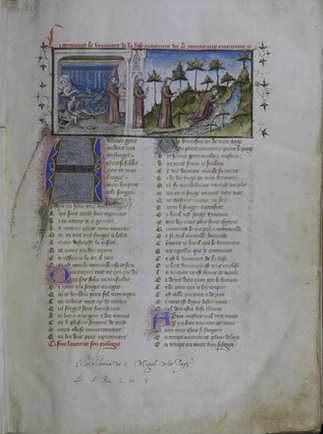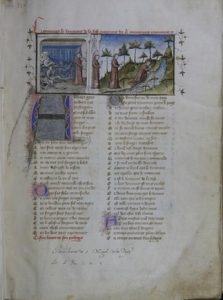The Roman de la Rose Digital Library team proudly announces the addition of three new manuscripts to our digital library. These additions bring the total number of manuscripts up to 145. This new batch is especially interesting because they are owned by libraries outside of France–we have two new German manuscripts and one from Spain. Each of these were originally produced in France in the 14th and 15th centuries.
Our first new manuscript, BH Ms. 387 comes to us courtesy of the Bibliotèca Històrica of the Universitat de València. With more than 160 beautiful miniatures, this manuscript is one of the most lavishly illustrated in the collection. Many of the illustrations span two columns in width. Heidrun Ost wrote an extensive essay about the illustrations in this manuscript. While it is not certain who commissioned the work, there is speculation that it was Philip the Bold, Duke of Burgundy. The style of illumination is similar to other manuscripts that the duke ordered for his collection. The Valencia Rose contains the usual text plus the “Testament de Jean de Meun”, the “Codicille de Jean de Meun”, and the “Articles de la Foy”.
The second new manuscript, Cod. gall. 80 is part of the collection of the Staatsbibliothek zu Berlin. This 14th century manuscript has smaller and fewer miniatures than our Valencia example, but they are all in brilliant colors. In addition, there are many decorated initials on every page.
Finally we have Ham. 577, also from the Staatsbibliothek zu Berlin. In addition to the text of the Roman de la Rose, this manuscript has a “mystery” section at the end. This section has many geometric illustrations, and does not appear to relate to the Rose. Can you help us with this? Please post a comment on this blog post if you can help with any information.
We owe a big debt of gratitude to the two libraries that supplied the images for these manuscripts. It is this type of community cooperation that enables us to continue to build this digital library.



This comment is from Lori J. Walters, The Harry F. Williams Professor, Modern Languages and Linguistics, Florida State University
The first page of the text informs us that it is L’image du monde, which is generally attributed to Gossuin de Metz. Of the three French redactions, the first was composed in 1246 and offered to Robert d’Artois, Louis IX’s brother. Many manuscripts of the text contain drawings such as those that are found in MS Ham 577. Just go to the wikipedia site and you will see similar ones. For more information, consult the entry on Gossuin in the Dictionnaire des Lettres françaises, pp. 555-56.